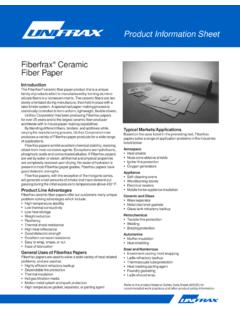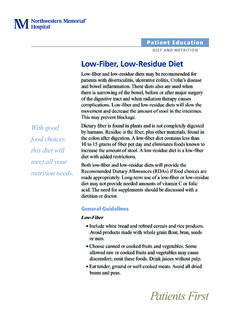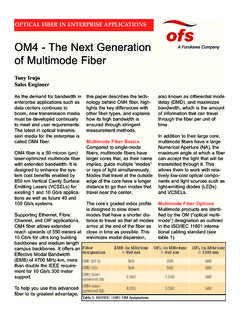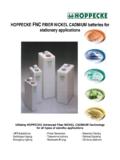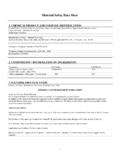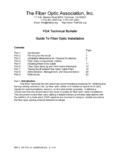Transcription of Fiber Rope Inspection and Retirement Criteria
1 Cordage InstituteInternational GuidelineCI 2001-04 Fiber RopeInspection and Retirement CriteriaThe Guideline that can Provide Enhanced Fiber rope Durabilityand Important Information forthe Safer Use of Fiber rope A Service of the994 Old Eagle School RoadSuite 1019 Wayne, PA 19087-1866 Cordage Institute 2004. All rights reserved. No part of thisstandard/guideline may be reproduced or utilized in any way orby any means (electronic or mechanical) without permissionin writing from the Cordage for Institute, 994 Old Eagle School Rd., Suite 1019 Wayne, PA 19087-1866 Tel: 610-971-4854 Fax: 610-971-4859E-mail.
2 Guideline CI 2001-04 Fiber rope Inspection and Retirement Criteria Guidelines to Enhance Durability and the Safer Use of RopeCordage InstituteInternational GuidelineCI 2001-04 First Edition Fiber rope Inspection AND Retirement Criteria Guidelines to enhance durability and the safer use of Fiber ropeThe use of rope and cordage products has inherent safety risks which aresubject to highly variable conditions and which may change over with standards and guidelines of the Cordage Institute does notguarantee safe use under all circumstances, and the Institute disclaims anyresponsibility for accidents which may occur.
3 If the user has any questions oruncertainties about the proper use of rope or cordage or about safe practices,consult a professional engineer or other qualified Guideline CI 2001-04 Fiber rope Inspection and Retirement Criteria Guidelines to Enhance Durability and the Safer Use of RopeTable of for Inspection and Materials and of AND RELATED specific to this terms and AND Retirement and Record Established Retirement rope Inspection AND of Records and Destructive AND EFFECTS OF Introduction [A].. Tension / Shock Loading [B].. Tension Wear [C].. Abrasion [D].. [E}.. Strands and Yarns [F].]
4 Fatigue Pulleys, Rollers, Chocks, Fairleads, Blocks [G].. Eyes and Other Terminations [H].. [I].. (cold flow) [J].. Compression and Kink Bands [K].. , Twist, Kink or Corkscrew [L].. Degradation [M].. and Heat Degradation [N].. Dirt and Grit [O].. Guideline CI 2001-04 Fiber rope Inspection and Retirement Criteria Guidelines to Enhance Durability and the Safer Use of PublicationsBRope Log Sample Mooring Line Log Towing Line LogCEvaluation GuideDIllustrations rope Types and Fittings Damage IllustrationsList of IllustrationsRope TypesFigure 13 Strand RopeFigure 28 Strand Plaited RopeFigure 312 Strand RopeFigure 4 Double Braided RopeFigure 5 Wire Lay RopeFigure 6 Jacketed RopeFigure 7 Climbing RopeFigure 8 ThimblesFigure 9 Plastic Thimble for Fiber RopeDamage IllustrationsD-001 Fiber Abrasion - Cyclic TensionD-002 Fiber Abrasion - Cyclic
5 TensionD-003 Inter-Stand AbrasionD-004 Matted Internal YarnsD-005 Uniform Surface AbrasionD-006 Extensive Surface AbrasionsD-007 Localized External AbrasionD-008 Localized External AbrasionD-009 Localized Jacket WearD-010 Burn and MeltingD-011 CuttingD-012 Cut in Jacket Core ExposedD-013 Pulled Strand in 8-Strand RopeD-014 Pulled Strand in Double BraidD-015 Pulled Strand in New RopeInternational Guideline CI 2001-04 Fiber rope Inspection and Retirement Criteria Guidelines to Enhance Durability and the Safer Use of RopeD-016 Damage Running Over PulleyD-0173-Strand Splice properly madeD-0183-Strand Splice poorly madeD-019 Wear in Double Braid SpliceD-020 Tearing in Eye SpliceD-021 rope with and without ThimbleD-022 Knot in Non-spliceable ropeD-023 HockleD-024 Corkscrew due to TwistD-025 Twist in 12-strand BraidD-026UV (sunlight) DegradationD-027 Dirt and GritInternational Guideline CI 2001-04 Fiber rope Inspection and Retirement CriteriaGuidelines to Enhance Durability and the Safer Use of Rope11.
6 PurposeCareful and frequent Inspection of Fiber rope , using procedurescontained in this document, reflects prudent safety managementrequired to protect personnel and property. This Guideline providesinformation and procedures to inspect ropes and to establish Criteria forevaluation. This document provides inspectors with help to makereasonable decisions regarding Retirement or continued use, includingrepairing or Basis for Inspection and Fiber ropes are employed in a large variety of applications thatdiffer greatly in the severity of use. In some applications, ropescan serve for many years. In more severe applications orunder different conditions, the same rope may degrade , ropes of different size, construction or material can showsubstantial differences in longevity in the same application.
7 Foreach specific Fiber rope application the user must establish abasis for Retirement that considers conditions of use,experience with the application and the degree of risk Section An inspector should always act conservatively when evaluatinga rope and making recommendations for further use. Residualstrength in a used rope can only be estimated and destructivetest methods are required to be definitive. The visual or tactilemethods described herein can only provide an estimate of Ropes that have been properly selected and used may be keptin service with some wear if inspected and evaluated inaccordance with these This document provides guidance for situations whereextensive usage history, documentation, Inspection facilitiesand testing laboratories are available; however, this is mostfrequently not the case.
8 Less comprehensive inspections arevery worthwhile and should be carried out. Actions that areconsidered minimal are marked Guideline CI 2001-04 Fiber rope Inspection and Retirement CriteriaGuidelines to Enhance Durability and the Safer Use of rope Materials and ropes covered by these Guidelines are made fromsynthetic fibers suitable for use in rope or from natural(organic) fibers. For descriptions and performance data forsynthetic fibers commonly used in rope refer to Ref. 1, CI 2003 Fiber Properties . rope constructions include the following: 3 and 4 strand laid rope - Figure 1 (3 strand only shown) 8-strand plaited - Figure 2 8 and 12 strand single braid - Figure 3 (12 strand onlyshown) Double braid - Figure 4 Wirelay - Figure 5 Jacketed Industrial and Marine Ropes - Figure 6 (braidedjacket construction is shown) Kernmantle (jacketed) Ropes - Figure 7 (rescue,climbing, rapelling) This guideline may apply to ropes of other materials andconstructions.
9 However, the inspector should seek advice fromthe rope manufacturer or other knowledgeable sourceregarding rope types not specifically identified Thimbles are an important part of many rope are used to protect the eye termination of spliced ropesand grommets and should be inspected if present. Figure 8and 9 show thimbles which are often used on Fiber This guideline does not cover the selection of rope types andmaterials for specific applications, nor does it provideprocedures for safe operation and use. Persons selecting ropemust consider their own experience or consult qualifiedpersons, rope standards, manuals, regulations, operatingguidelines or the rope manufacturer for information onselection and use of Fiber rope .
10 See Appendix A for a partiallist of reference publications regarding rope Guideline CI 2001-04 Fiber rope Inspection and Retirement CriteriaGuidelines to Enhance Durability and the Safer Use of Order of In the event of conflict between the information in this guidelineand other guidelines, standards or regulations, the user mustdetermine the order of precedence. When in doubt consult withappropriate REFERENCES AND RELATED ReferencesThe following Cordage Institute (CI) and other publications provideadditional information about the properties, testing, care and safe use offiber ropes:1. CI 2003: Fiber Properties (Physical, Mechanical andEnvironmental) for Cable, Cordage, rope and Twine2.

